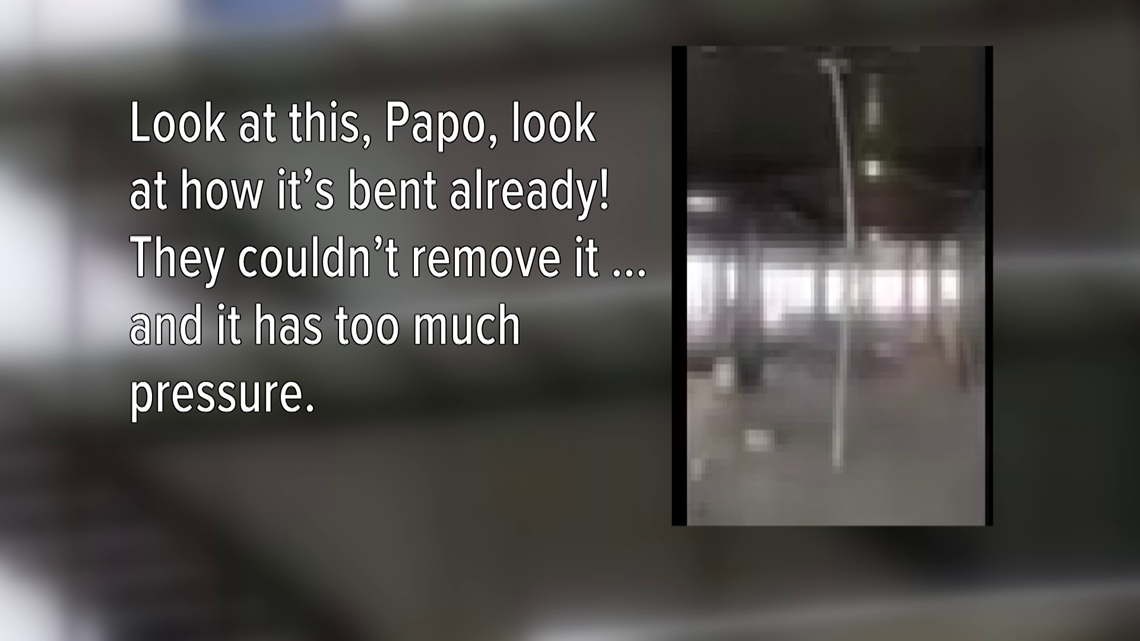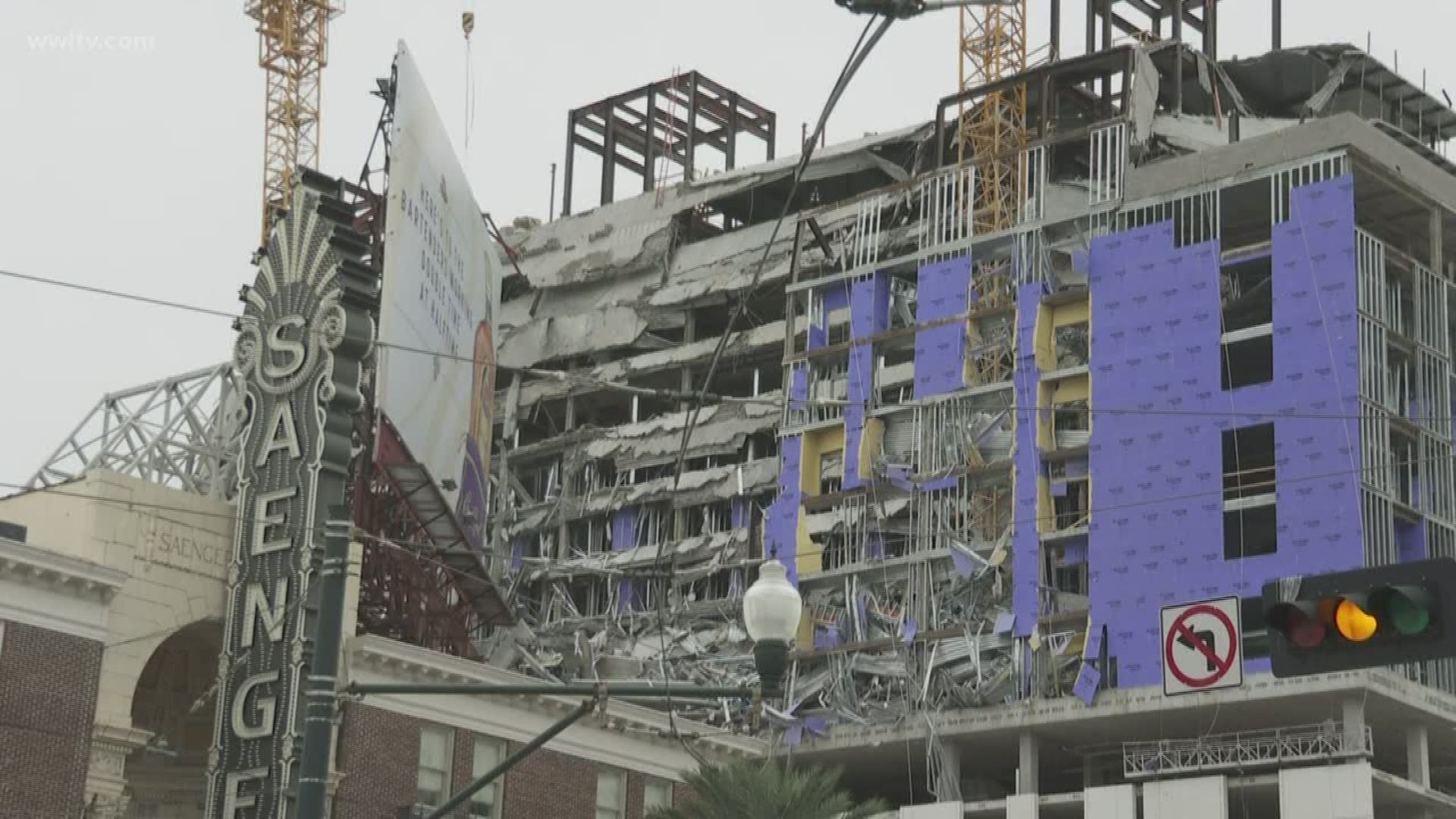NEW ORLEANS — As authorities shifted Wednesday from rescue operations to safely tearing down the dangling wreckage of a half-built Hard Rock Hotel, theories began to take hold over just what compromised the concrete slabs that rose in tiers above Canal and North Rampart streets until they pancaked Saturday morning, killing at least two workers.
Images of the hotel under construction before and after the fatal collapse have fueled speculation of contractor shortcuts and criticism from some workers.
Several people who were employed on the $85 million hotel project said they’d expressed concern over the structure as they built it, and video evidence of those concerns appeared late Tuesday on social media.
Shot by a local contractor, the video purports to show the concrete slab above an upper level of the Hard Rock sagging to the point of bending the temporary posts, called shoring jacks, that supported it.
Randy Gaspard, a local concrete contractor who posted the video, said it was shot by a worker on Thursday, two days before the hotel collapse. Gaspard declined to identify the worker by name or say who employed him.
“Look, Papo, 'the best engineering!' Look at these large stretches (between supports) and s--t beams! (unintelligible) They’re already to the point of breaking," the worker, narrating in Spanish, says in the video.
"Look at how it’s bent already! They couldn’t remove it because it's too bent and it has too much pressure. The huge spaces without beams – look! What a very s--t structure these architects and engineers are building! … This is seriously bad, Papa!”
Gaspard said he’s been told workers had been removing the temporary posts, and “when they got to less and less of them, got more and more load on ‘em,” they tried to tell the contractor to stop but were told to keep going.
“What it shows is that the concrete deck has so much deflection that they can’t remove the shore posts,” Gaspard said. “They have so much load on them, it’s bending them.”
New Orleans Fire Department Superintendent Tim McConnell said Wednesday that officials are aware of the video and that it has become a piece of evidence in the investigation.
Federal investigators with the Occupational Safety and Health Administration began their work Saturday, within hours of the accident. The agency's inspectors were given New Orleans police body cameras to document the hotel ruins. McConnell said any decision on whether to pursue criminal charges over the building's collapse, or the resulting deaths and injuries, would stem from what OSHA finds.
One foreman for a subcontractor on the project, who said he was off Saturday when the building collapsed, described another flaw. He claimed contractors failed to properly install the metal pan into which concrete is poured for the building’s floors.
That corrugated metal decking was positioned differently along the edge of the building above North Rampart Street than elsewhere on the building. Metal sheets were meant to overlap, but instead were installed perpendicularly, the worker said -- something he suspected caused a “shearing point” and may have contributed to the collapse.
A former ironworker who requested anonymity under the advice of his attorney shared that theory and blamed a series of changes to the design that were made during construction.
“It wasn’t the ironworkers. We did everything to engineered specs. I wondered if the engineers were really okay with it,” said the former worker. “The whole crew joked about how bad it was. We all joked we’d never stay in that hotel.”
Not surprisingly, the firms involved in the project declined to entertain speculation over what caused the collapse.


Brian Trascher, a spokesman for the contractor on the hotel project, Metairie-based Citadel Builders, questioned the provenance of the video and cautioned against drawing any conclusions from it.
“I think there’s a lot of Monday-morning quarterbacking going on, a lot of people trying to flex their engineering muscles because this happened,” he said.
Trascher said top experts have been brought in to assess the collapse, including those who worked on the World Trade Center collapse on 9/11, and in the 1995 Oklahoma City bombing.
“These people don't live on Facebook for a living, they do this kind of a thing for a living, and I think we're going to follow their advice,” Trascher said.
The principal engineer on the project, Heaslip Engineering, issued a statement Wednesday that described the firm as “devastated” by the collapse. James Heaslip, the firm’s founder, did not speculate in the statement over what caused the collapse.
“As a member of the design team, we are keenly interested in finding out why this incident occurred,” the statement from founder James Heaslip read.
Yet another theory on a potential spark for the hotel collapse came from a Texas engineer who inspects bridges for that state.
Linwood “Woody” Howell, of Austin, pointed to a “scissor lift” from drone footage of the hotel wreckage. The video and other photos show the heavy lift propped up on a pile of rubble.
That Genie 1930 model weighs nearly 3,000 pounds, and Howell suspected that, like a stiletto heel, its weight could have pierced a concrete floor that was supported by only “point shores” like those shown in the worker’s video, not beams that would better distribute weight.
Howell said his rough calculations based on project drawings and specs from the maker of the steel decking indicated “the floor system design was pushing the structural limits of product capability, leaving little tolerance for error.”
"If the scissor lift failed one section of the top floor, then the falling weight of the floor and scissor lift would collapse floors below and eventually buckle columns and pull down areas adjacent to the failed section," Howell said. "This scenario is consistent with the video of collapse and other currently available data."
Another construction expert suggested all those problems could have been factors in the collapse.
Previous Coverage on WWLTV.com:
Aaron Maclean, a California consultant who testifies as an expert witness in construction defect litigation, pointed to the dramatic difference in the size and spacing on the beams on the building’s top two floors compared to the heftier and more closely spaced supports on those below. “Just looking at it, there seem to be a whole lot of big spans and not a lot of strength," Maclean said, stressing he was commenting solely on structural drawings of the building, photos and the video posted to Facebook.
Based on photos of the site, it also appears the beams supporting the cantilevered edges of those floors did not extend far enough into the building to properly anchor them, Maclean said.
And then there’s the potential use of the scissor lift and the piles of heavy materials that photos show were stored on the top level of the site. It’s possible the weight of those materials, or the removal of temporary supports that shored up the top floor, could have resulted in a catastrophe as the weight and momentum of the top floor crashed into the one below it and the collapse cascaded into lower floors.
“You take any one of those things by itself and it’s not a whole lot to worry about,” Maclean said. “But you put all those things in succession, and you’ve got a recipe for disaster.”
One retired structural engineer cautioned about relying on the impressions of workers on the project.
"While they are qualified to put the pieces together, they are not qualified to opine on what those pieces are and what they should be," Ashton Avegno said.
He also downplayed the idea that the position of the decking could have led to the building's collapse.
"You need to bear in mind that the permit drawings are not final and many additions and changes are commonly made between permitting and actual construction," Avegno said. "The direction of the deck span does not matter as long as the support beams were properly designed and constructed."
One suspicion that seems to have been debunked: That a swimming pool that was lifted from Rampart Street onto an upper level of the hotel may have sparked the collapse.
That pool was installed Thursday on a 9th floor deck, where it remains, said Greg Carnforth, vice president of Chester Pool Systems of Indiana.
Carnforth said another pool planned for the hotel's rooftop had not yet been installed when the top floors fell.
Ed. Note: Times-Picayune/New Orleans Advocate staff writers Jeff Adelson, Matt Sledge, Gordon Russell and Ramon Antonio Vargas contributed to this report.

